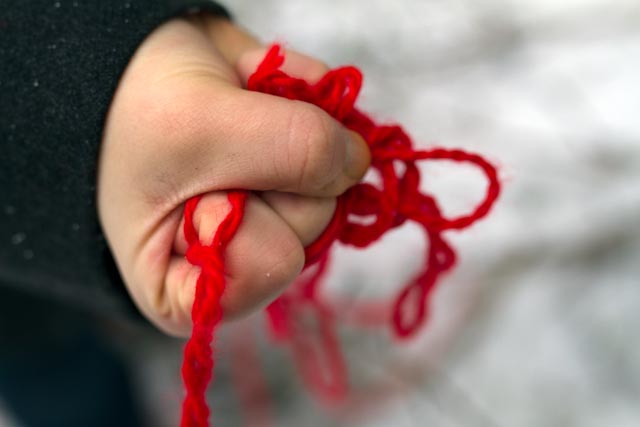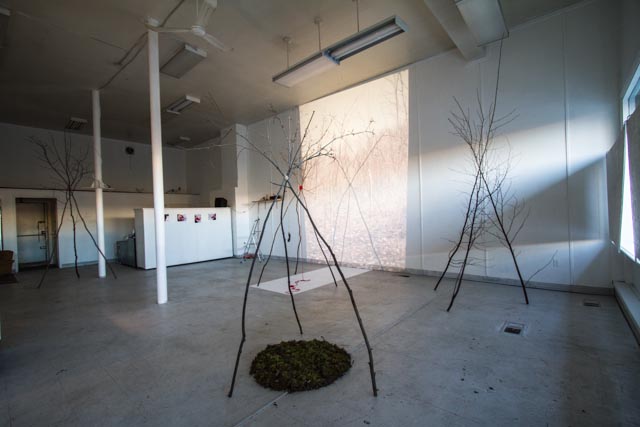The Neighbourhood Time Exchange | Downtown Prince George took a brief hiatus during the often-disrupted month of December. Rather than hosting an artist-in-residence, the project made room for a takeover of the studio space by community members. The residency program’s Project Coordinator Roanne Whitticase organized several locally-inspired events, including an exhibition of work by Prince George-based artist Joanna Smythe, and other evenings filled with music, art and craft-making. Despite the freezing weather, many came out to share in the cultural activities taking place in the studio.
An active artist for many years, Joanna Smythe holds a MAA from Emily Carr University of Art and Design as well as a joint BFA in Creative Writing and Visual Arts from Emily Carr University of Art and Design and the University of Northern British Columbia. The artist’s writing and visual art practices share a permeable boundary, reminiscent in some ways of theatre’s tendency to merge literature and performance. In fact, the exhibition inspired a reflection upon many aspects of “staging”, marking out an arena from which to evaluate human and non-human actors in environmental relations. The exhibition at the Neighbourhood Time Exchange | Downtown Prince George studio space featured sculpture, projection, photography, and a narrative poem that was available as a printed leaflet and also read aloud by the artist in the soundtrack of a video work. The words filled the belly of the space with thoughts of streams, rocks, the rustling of leaves, and the falling of snow.

To “spin a yarn” is to tell a long, perhaps wavering, story that leads many places. In Smythe’s installation, this yarn travels through the exhibition as a bright red bundle that literally reappears throughout the many multimedia artworks. Near the entrance of the exhibition is a wall-mounted circle of astroturf grass. Clinging to it are fistfuls of red yarn, the only adhesive being the inherent velco-like relationship between the artificial grass and the soft wollen fibres. This uncanny form of attraction by, or to, the artifice, is a concern that tends to reappear throughout Smythe’s art practice. Her work frequently examines the romanticized and constructed way we interpret our relationship with nature. The exhibition is united by works that are highly mediated and carefully anchored into the space.

Walking further into the exhibition space, the red yarn tethers together a tripod of towering, wiry branches. As the yarn wraps the boughs, it is wound over and around itself so many times it begins to resemble the ball of yarn it perhaps once was. Projected over this sculptural piece is an image of the exact same structure, but set against the backdrop of the leaf-littered autumnal forest where we suspect these elements originally came from. Here, the yarn, or the narrative, begins to echo. The structure in our physical presence is also presented somewhere else; the shadows of one instance rub off on the other. These visual and narrative echoes and repeated motifs reverberate off of all the elements in the exhibition, both inside and “outside” the gallery space, destabilizing the viewer as to where one piece begins and the other ends. Rather than the neat and tidy divide that Western philosophy has made between the natural and the cultural (an artifice of its own that deserves examination), Smythe complicates this binary. How much of our experience of nature is simply what we tell ourselves about nature?

This question is articulated in the narrative poem read aloud in the video, which begins with a young girl in a bright red knitted scarf in the heart of the woods. She finds the end of a piece of yarn and grabs ahold of it. As she moves throughout the woods, it becomes in equal parts a guide (tethering her to the places she knows, where she has been), and a hindrance (catching and snagging on everything she walks by, making it all the more difficult to move forward). This complex entanglement, between story and movement, is central to many of the works.
Throughout the exhibition, both knots of trees and knots of narrative are shared sites from which to explore the social lives of stories. How these stories inform our relationship with nature is an increasingly relevant concern in contemporary culture. Taking a cue from the exhibition, perhaps a part of this is to learn how to listen at the edge of looking.
